Pelkor Chode Monastery Overview
Located 100 km east of Shigatse, Pelkor Chode Monastery is a monastery with the characteristics of Han, Tibetan and Nepali architecture. It enjoys a high status in Tibet Buddhism history because it houses three sects – Sakyapa, Kadampa and Gelugpa together. According to Tibetan calendar, Saka Dawa Festival will be held on April 15th to commemorate Sakyamuni, the founder of Buddhism. During the festival, about 500 Lamas chant sutras and the loyal pilgrims gather in the monastery to commemorate Sakyamuni.
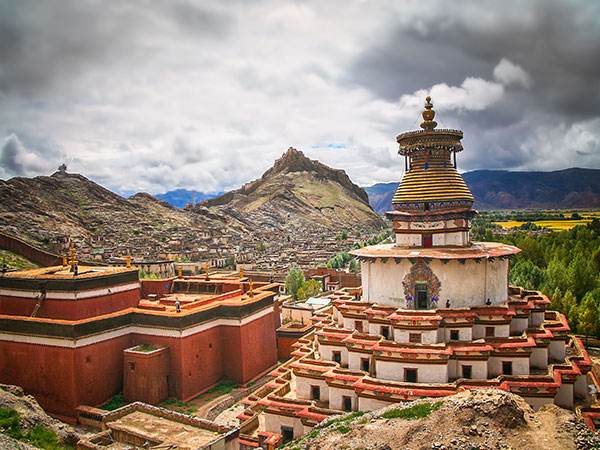
Pelkor Chode Monastery is very different from other monasteries with its unique structure. It lies at the foot of Dzong Hill, 230km south of Lhasa and 100km east of Shigatse.
History
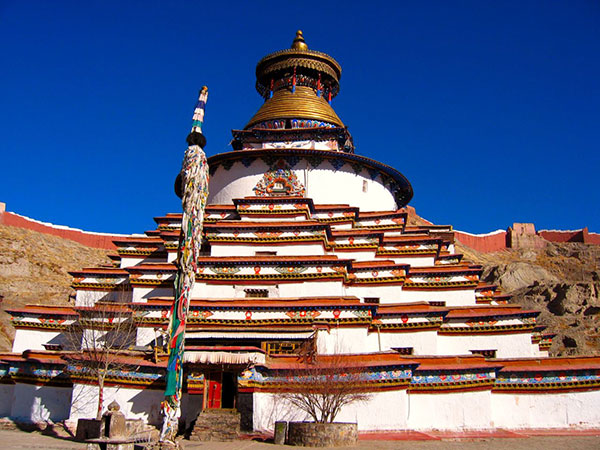
Palkhor Monastery consists of Tsuklakhang, Kumbum, dratsangs and wall four construction units, which is building of Ming dynasty. Palkhor Monastery was built by Prince Rabton Kunzang Phak and 1st Panchen Lama Kedrub Je in the first half of the 15th century (1418-1436). Kedrub Je (1386-1438) in his early years studied Buddhism with the sakya eminent monks to, quickly became buddhist master proficient in Pancavidya. In 1413, in order to preach Buddhism in Gyantse, Rabten Kunzang Phak (1389-1442) invited Kedrub Je to preside over Buddhism affairs, and developed the land of Gyantse Manor and the upper part of the castle into monastery, and started building in 1418 AD, was completed in 1425 AD. The monastery is for three-storey flat-topped Tibetan architecture, the plane is for Mandala model.
In 1904 for the second time British expedition to Tibet, the British captured Gyantse Dzong and then attacked and occupied Palkhor Monastery. The British who occupied Palkhor Monastery robbed a large number of cultural relics, the scriptures, and so on in the monastery, changed the Buddhist temple to the dining room and knocked prayer wheel in a nail and turned into food conveyor belt. After the battle, the British killed many of the Tibetan people and occupied the whole Gyantse.
Before the democratic reform in 1959, Palkhor Monastery has 1500 monks, presided over by the gelug sect monk, and the khenpo of Palkhor Monastery was dispatched by Sera Monastery Khangtsens. In 1977, China allocated funds for comprehensive maintenance of Palkhor Monastery. And the repaired parts opened in December 1979. In 1998 Palkhor Monastery was listed as the fourth batch of national key cultural relics protection units.
At the beginning of the 21st century, the government approved the authorized strength of Palkhor Monastery monks are 80, of which the gelug sect of 40, sakya sect of 20, Shalu sect of 20, 20; Actual monks are 76 people, among them 43 monks belong to the gelug sect, 21 monks belongs to sakya, 12 people belongs to Shalu sect.
Festival
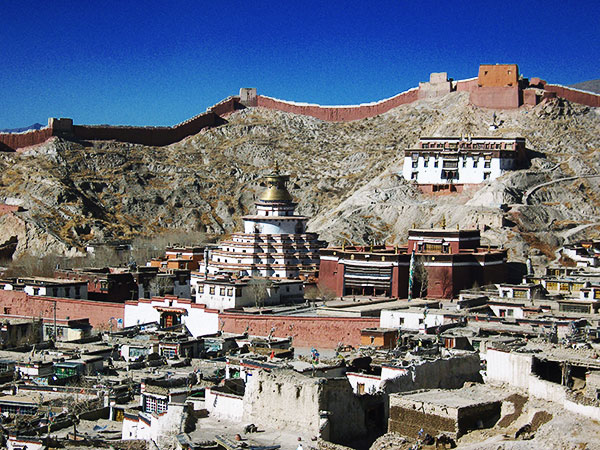
It enjoys a high status in Tibet Buddhism history because it houses three sects – Sakyapa, Kadampa and Gelugpa together.
According to Tibetan calendar, the Gyangtse Dhamang Festival, also known as the Gyangtse Horseracing & Archery Festival will be held on April 19 in Tibetan calendar. It began in 1408 which is the oldest festival in Tibet with 600 years history. Traditionally, the festival includes archery, horse races, and shooting on galloping horseback, and so on. Nowadays, the contents of the festival are many and varied, such as folk songs and dance, ball games, picnicking, track and field events, as well as barter trade. Religious activities also are part of the event.
It is said that Dhamang Festival began in the Gyangtse area, Gyantse prince of Dharma Rabten Kunzang Phak’s grandfather was the interior minister of Issachar dynasty, and also prince of Dharma of Gyantse, who had a good prestige among the masses. After he died, his disciples sacrificed and worshiped him every year. Later due to the war, the sacrifice was interrupted. Until Tibetan year of the fire mouse (Gregorian calendar 1408), Rabten Kunzang Phak became prince of Dharma and he followed his father’s will, resumed the sacrifice activity. From April 10th this year to April 27th, Rabten Kunzang Phak chanted Buddhist scripture for his grandfather, until 28th, recreation got under way.
What to See
Palkhor also features its Bodhi Pagoda, or Kunbum in Tibetan. Deemed as the symbol of the monastery, the spectacular Stupa consists of hundreds of chapels in layers, housing about a hundred thousand images of various icons, in total there are about 3,000 statues.
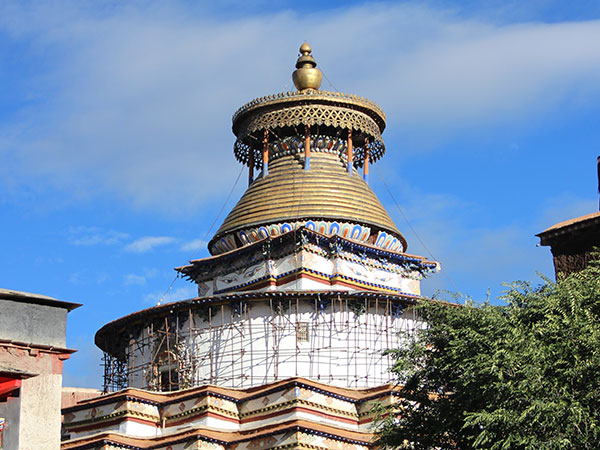
【Gyantse Kumbum】
In the Palkhor Monastery it has a well-known Palkhor Pagoda, and also named “Bodhi Stupa”. The river surrounded is Nianchu River of Shigatse. Palkhor Monastery first built in 1418 AD by Rabten Kunzang Phak and first Panchen Kedrub Je, which is the most majestic well-preserved, colorful architectural treasure by far in Tibet. It is a nine-storey pagoda with a height of 32 meters with 77 chapels, 108 doors, and shrines and chanting halls, which is unique treasure in the history of Chinese architecture. There are also more than thousands of Buddhism statues manufactured with mud, bronze and gold. Kumbum is praised as museum of Buddhism statues since a large quantity of Buddhism statues are stored here. Tourists could climb to the top of the pagoda through the stairs up to the top. People can go in the west entrance of the pagoda and go up stairs to the top of the pagoda, but if you can’t find the stairs, best looking around, some of the stairs couldn’t be found easily.
Upon the 5-storey base of the pagoda is roundness, the top is cone covered by copper sheet. At the cardinal points of the first storey of the Kumbum is stairs that lead to the second storey, accompanied with the main entrance in the southern side. The second storey has 20 chapels decorated with images of Kriyatantras and arranged in a clockwise order. The third storey has 16 chapels and also house with images of Kriyatantras along with Caryatantras in a clockwise order. In the fourth storey, there are 20 chapels with Yogatantras images in a clockwise order. The fifth storey has 12 chapels depicting lineage holders. In the sixth storey there are 4 chapels, which display Yogatantra deities. The seventh storey is a single chapel with 10 mandalas, a unique depiction of the “Father Class of Unsurpassed Yogatantras”. The eighth storey is also a single chapel same as seventh storey but depicts 11 mandalas of “Mother Class of Unsurpassed Yogatantras”. The last storey has a single chapel, which has a statue of the Vajradhara Buddha but is “flanked by the masters of the Kalachakra”.
【The Assembly Hall】
Tsulaklakang is the main temple. It has an Assembly Hall called as ‘Tsochen’ in Tibetan and well preserved. The structure is three-storey and has well preserved murals and images of the fifteenth century.
The main assembly hall of Palkhor was built between the end of 14th century and the beginning of the 15th century. The ground floor of the three-story building is a Chanting Hall with 48 columns decorated with tangkas. An eight-meter high bronze statuary of Maitreya ia also on display and the gilded figure is made from 1.4 tons of bronze. On the second floor, Bodhisattva Manjushri and Arhats from the Ming Dynasty were enshrined in the chapels. Its Arhat Chapel is famous throughout Tibet. On the roof, a chapel houses a collection of 15 mandala murals, which are three meter in diameter. The monastery collects about 100 robes and costumes worn in Tibetan opera, all of which were made of silk, embroidery and tapestry during the Ming and Qing Dynasties.
【Other buildings】
Centered on the Assembly Hall and Kumbum, there are many dratsang and Buddha-hall: Guba Dratsang, Devachen Dratsang, Saigong Dratsang, Rending Dratsang, Lahgang Dratsang, etc. 17 dratsangs; Marin, Rongkang, Ganden, Kaiju, Baju and so on the Buddhist-hall, and monk living quarters, general layout presents oval. The 17 dratsangs belong to Tibetan Buddhism Gelug sect, Shalu sect, Sakya sect respectively, and most of dratsangs are Gelug sect with 7 in all. At the beginning of the 21st century, dratsang only left three in all that is the one gelug sect dratsang, one sakya dratsang and one shalu dratsang. The sectarian groups coexist in one monastery of Palkhor Monastery, this kind of situation is relatively rare in Tibet.
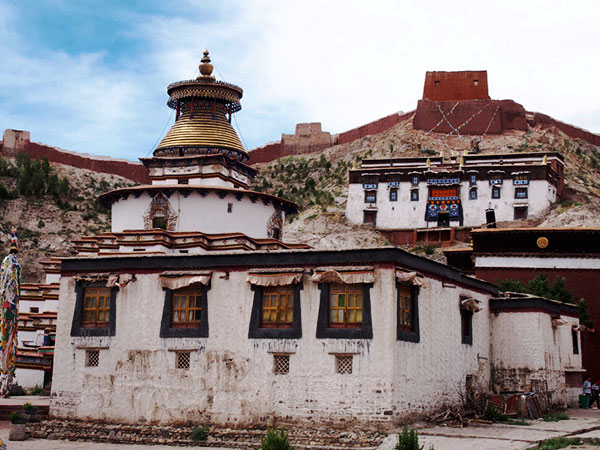
Travel Guide
【Chinese Name】: 白居寺
【Recommended Visiting Hours】: 2 hours
【Best time to travel Palkhor Monastery】: It is suitable to travel in four seasons, because the sunlight of Shigatse region is sufficient, and the climate is moderate. But the summer and autumn is the best time to travel.
【How to get to Palkhor Monastery】: Palkhor Monastery lies at the downtown of Gyangts County. Walk along the stone road if you see the white pagoda or white walls, then you’ll find the monastery not far away.
